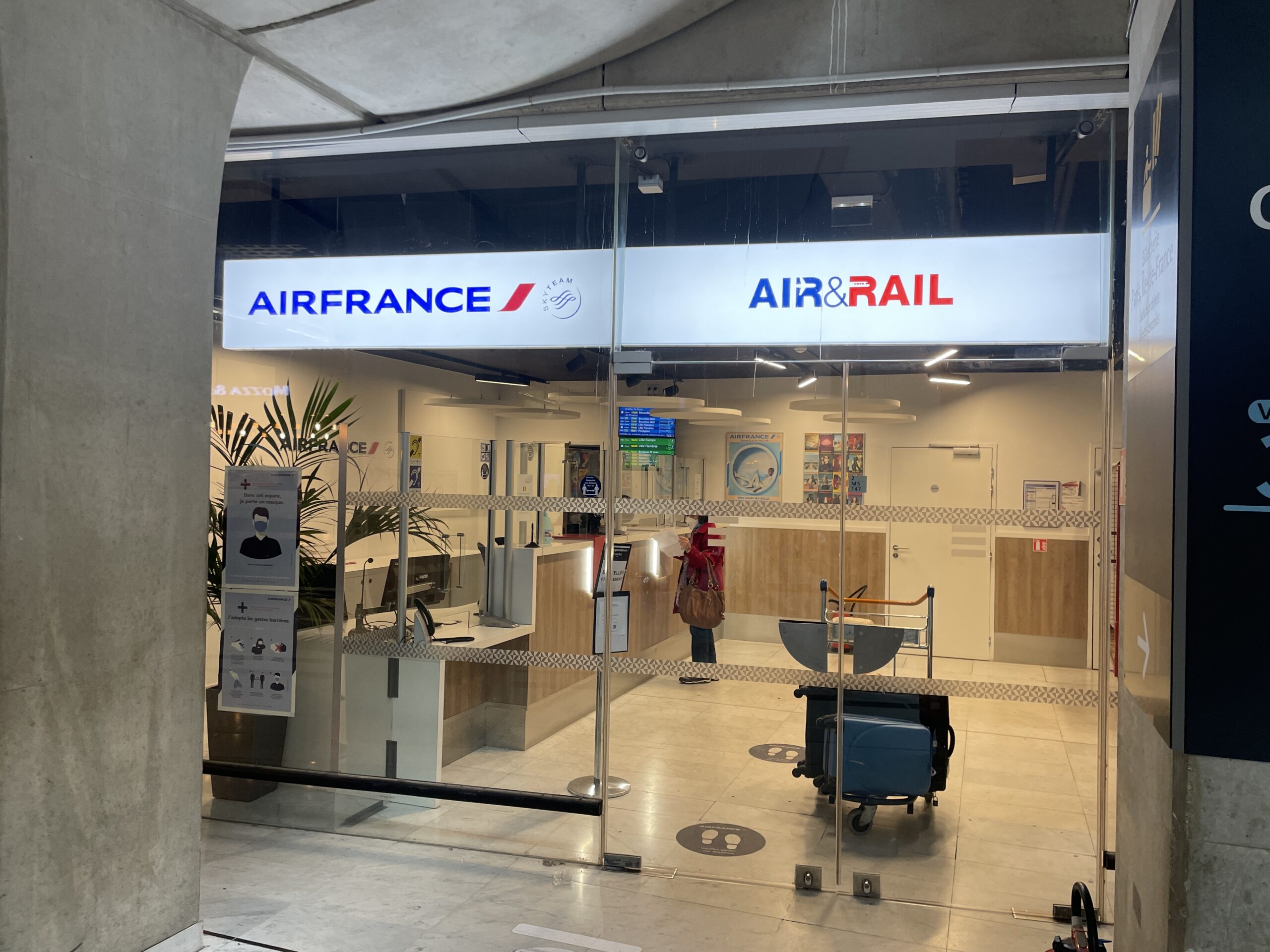Photo credit: An Air France Train + Air office in the train station at Paris Charles de Gaulle airport. Airline Weekly / Edward Russell
Paris Charles de Gaulle is among the few airports in the world that benefits from a high-speed passenger rail station in the terminal. That intermodal connectivity allows Air France to be among the leading airlines offering air-rail connections, whereby passengers book combined flight and train journeys on a single ticket.
But having an intercity rail station in the terminal does not mean the passenger experience is good. There is little signage directing travelers who arrive off a domestic France flight and are connecting to a train on an Air France Train + Air ticket. If they have checked luggage, travelers must claim their bags at baggage claim and transfer them themselves to the train. And, until last fall, they needed to stop at an Air France office in the high-speed TGV rail station to collect their train ticket.
“The experience was not so good,” Air France CEO Anne Rigail said of the airline’s Train + Air connections at Charles de Gaulle in a recent interview. And the numbers show that: Only about 160,000 passengers annually book joint air-rail tickets on Air France. That compares to the roughly 575,000 passengers that used Lufthansa’s similar air-rail offering with Deutsche Bahn at its Frankfurt hub before the pandemic.
Now, Rigail wants to boost those air-rail numbers with what some might call its an out-of-the-box approach: Making the transfer experience good.
Air France expanded its Train + Air program to 33 routes from Charles de Gaulle during the pandemic. Rigail wants to further expand the number of routes, including to destinations where “there is no airline service.” And, beginning late last year, Air France improved the digital experience by allowing travelers to check in for their entire journey — both flights and trains — on the Air France app.
“What we want to do … you come by train, you can drop your luggage immediately with a drop-off facility that is really connected to the station,” Rigail said. “And the ultimate experience is to go directly to a people mover to reach your boarding gate. That’s the intention. It won’t be quick to deliver, but we are definitely working on it with our partners.”
“We will definitely increase [the number] because of [of the] better experience,” she added.
Expanding air-rail connectivity is not an entirely altruistic endeavor for Rigail. Air France-KLM has set a goal of cutting carbon emissions per revenue kilometer 30 percent by 2030 from 2019 levels, and achieving net-zero emissions by 2030. The group has even issued bonds with the interest rate tied to meeting emissions reduction targets. Trains, as is well known, emit far less carbon than planes on routes where they compete.
Air France also faces shifting public opinion in Europe towards air travel. France passed a landmark climate law in 2021 that bans flights on routes where trains can make the journey in two-and-a-half hours or less; flights serving connecting travelers are still allowed. The ban was upheld by European Union regulators last year. And, as Air France-KLM CEO Ben Smith noted in February, there has been a big shift in French corporate travelers to trains even on routes where flights are still allowed, for example between Paris and Marseille. TGV trains make the Paris-Marseille run in as little as 3 hours and 15 minutes.
Rigail described the shift in traveler demand on the Paris Orly-Marseille route as “so strong [and] so quick” that Air France has more than halved the number of flights it will offer this summer compared to a year ago.
Airport constraints are also making air-rail connections more attractive to airlines. Hubs in Amsterdam and Frankfurt are both expected to face capacity constraints again this summer. Lufthansa Group CEO Carsten Spohr, in comments on capacity challenges in Frankfurt, earlier in March spoke positively of intermodality and rail connections. He cited the example of Dusseldorf where the airline has reduced the number of flights from Frankfurt to four from 10 by shifting travelers to trains.
Deutsche Bahn in February said demand for joint air-rail trips with Lufthansa was up 25 percent last year compared to 2019. The German rail operator is in the process of becoming Star Alliance’s first intermodal partner, and also has codeshare agreements with Etihad Airways and Qatar Airways
“We really need to promote going by train within 500 kilometers — 500, 600 kilometers,” KLM CEO Marjan Rintel said in November. Rintel, a former Dutch railway executive who took the top spot at KLM last year, faces potential capacity cuts at the airline’s Amsterdam Schiphol hub this fall as the government of the Netherlands seeks to reduce noise and cut emissions. KLM, along with a number of other airlines, has sued to stop the reductions.
KLM is expanding its partnership with high-speed rail operator Thalys this summer. The airline will buy more seats for connecting passengers on trains to Brussels, for one, this summer. However, KLM has only reduced its Amsterdam-Brussels schedule by one flight, to up to four daily, so far.
Outside of Europe air-rail connectivity is limited. Intercity rail networks in many places are limited, and few airports have stations that allow for direct connections. Some airlines, including Finnair and United Airlines, are using buses instead of planes for short routes from their hubs where there is not rail service.
Special Offer: Choose From Quarterly or Annual Subscription Plans
{{monthly_count}} of {{monthly_limit}} free stories left to read
SubscribeAlready a member? Sign in here
You Need an Airline Weekly Susbcription to Read This Story
Your story count resets on {{monthly_reset}}
Already a member? Sign in here
